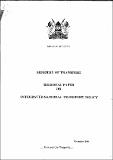| dc.description.abstract | As we implement Kenya's Long Term Development Strategy, Vision 2030 Kenya is looking to the future with
the aim of consolidating, enhancing and sustaining the gains of the Economic Recovety Strategy for Wealth
and Employment Creation 2003-2007" (ERS). The transport sector is recogi;iized as a key pillar and a critical
enabler in the achievement of this strategy. lt will be important not only in improving the competitiveness of
products from Kenya and the region, but also serve as a significant basis upon which the economic, social and
political pillars of this long term development strategy will be built. Further, the sector is expected to remain
a key component in achieving the Millennium Development Goals (MDGs).
Given this envisaged economic development and subsequent sustained growth, in the context of changing
population and land use patterns, a competitive regional and global economy, strategic nation building
considerations and new market development, it is apparent that the task of transport sector will be highly
complex and demanding. | en |




